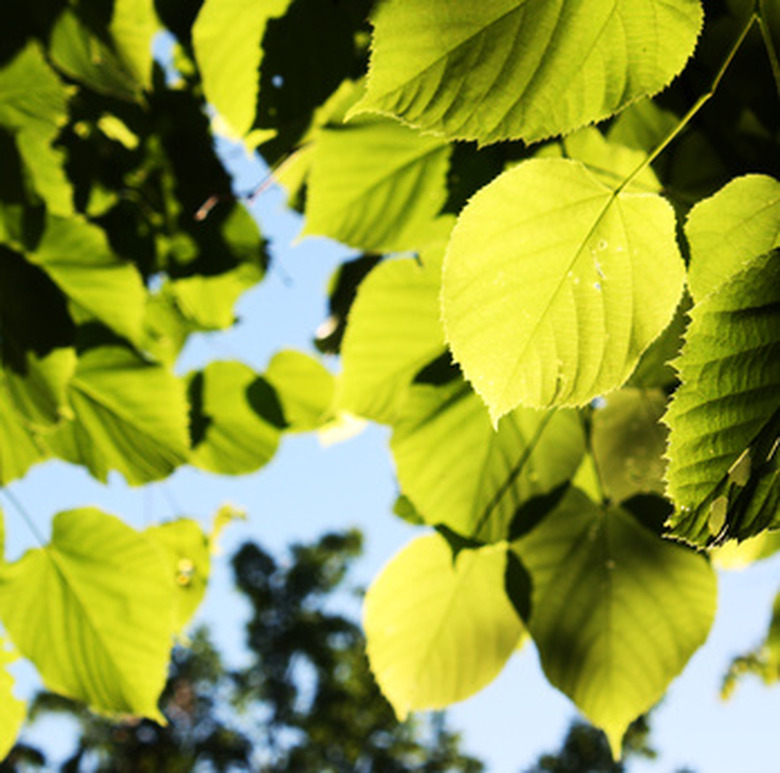American Linden Tree Facts
American linden (Tilia Americana), a tree that has nicknames such as basswood and bee tree, is one of the premiere shade trees throughout its range. American linden exists in the Northeast in the United States and through much of the Mid-Atlantic states, Great Lakes region and to the eastern edge of the Great Plains. The tree features large leaves that provide plenty of shade, plus fragrant flowers that attract bees looking for tasty nectar.
Identification
The average height of the American linden ranges from 60 to 125 feet, with the tree attaining a rounded form with a canopy of spreading branches. The leaves have a heart shape, are as long as 5 1/2 inches, as wide as 3 inches and have serrated edges. One of the attractive aspects of the tree is the dark green color of its foliage during spring and summer; the fall color is usually another shade of green or a faded yellow. The flowers are small, creamy-white and aromatic. They develop into pea-sized seeds favored by birds, squirrels and other animals. The furrowed bark is brown-gray.
- American linden (Tilia Americana), a tree that has nicknames such as basswood and bee tree, is one of the premiere shade trees throughout its range.
- One of the attractive aspects of the tree is the dark green color of its foliage during spring and summer; the fall color is usually another shade of green or a faded yellow.
Growing Conditions
In the wild, the American linden grows best on floodplains and near wetlands. Conditions that offer full sun will allow the tree to flourish. If you have a site that features deep topsoil with solid drainage, this is where the American linden should go. Keep the tree out of places where soil compaction exists and remember that a basswood is quite sensitive to the effects of drought, meaning you need to monitor the weather and water your seedling.
Insect Pests of Linden
While a variety of insect pests will flock to the linden tree, few have any lasting effects on it. A bug called the linden borer will carve out tunnels at the bottom of the trunk, which can be problematic for weak seedlings and older specimens. Insects such as the linden looper, spring cankerworm, gypsy moth caterpillar, tent caterpillar and the basswood leafminer will all eat the leaves of the American linden. Perhaps the tree's biggest insect nemesis is the Japanese beetle, a bug that can defoliate large areas of the tree.
- In the wild, the American linden grows best on floodplains and near wetlands.
- A bug called the linden borer will carve out tunnels at the bottom of the trunk, which can be problematic for weak seedlings and older specimens.
Linden Diseases
American linden is susceptible to certain diseases that affect the leaves, with black mold and leaf spot two of these ailments, but usually the tree withstands any symptoms that result. Any injury to the trunk or branches of a linden tree can allow organisms that bring about decay to enter the wood. This can become serious, as basswood will decay more readily than many other types of trees. Different varieties of fungi, such as yellow cap fungi, are often the culprits in causing wood rot in this species.
Considerations
Keep an American linden tree away from large paved areas, as the reflection of the heat from the asphalt tends to damage the leaves. Cultivars exist of the species that have larger leaves than the original. Those that are severely allergic to bees will need to take care around the tree when it is in bloom in late spring. Honey producers station their beehives close to an American linden. The wood from American linden is odorless and so lightweight that such products as hunting decoys, wooden dishware and the frames for fish nets come from it.
- American linden is susceptible to certain diseases that affect the leaves, with black mold and leaf spot two of these ailments, but usually the tree withstands any symptoms that result.
References
- Ohio Department of Natural Resources: American Linden
- United States Forest Service: American Basswood
- University of Florida Institute of Food and Agricultural Sciences: American Basswood
- "National Audubon Society Field Guide to Trees"; Elbert L. Little; 2008
